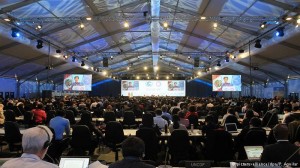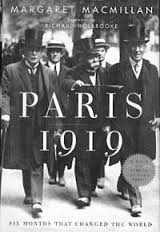
As discussed in a post in November, the climate deal between the United States and China have, for the first time, given me some hope that the world might actually negotiate a comprehensive settlement on slowing down or mitigating profound changes to the environment. The agreement struck in Peru a couple of weeks ago also appears largely positive and sets the stage for an international climate conference in Paris next December.
The Paris climate conference has the potential to affect the 21st century, much as the Paris Peace Conference of 1919 can be said to have shaped the 20th although I fear that the parallels between the two conferences go even further.
20 years of talks
As I have written in the past, I have been extremely skeptical about the political process connected to this issue as well as its impact on the science which underpins the entire climate discussion.
The scientific organization, the Intergovernmental Panel on Climate Change (IPCC), was created in 1988 and made its first report in 1990. In 1992, the UN’s Framework Convention on Climate Change was adopted in Rio and the first conference of the countries which agreed to the framework was held in Berlin in 1995. The meeting in Peru was the 20th meeting of the same countries and Paris will be the 21st.
 Over the years the talks have moved from place to place and adopted different agreements, often taking the name of the city in which the talks were held. At the request of Manuel Pulgar-Vidal, the Peruvian environment minister, the agreement reached is now called the Lima call for Climate Action. The agreement is worth reading and can be found at the UN’s web site.
Over the years the talks have moved from place to place and adopted different agreements, often taking the name of the city in which the talks were held. At the request of Manuel Pulgar-Vidal, the Peruvian environment minister, the agreement reached is now called the Lima call for Climate Action. The agreement is worth reading and can be found at the UN’s web site.
The basic idea is that every country will, by the first quarter of 2015, tell the U.N. what it intends to do about managing its carbon footprint through 2020 and beyond. The U.N. will then add up all of the countries planned emissions and then determine how much trouble the planet is likely to be in before the Paris meeting. At issue is weather the plans announced will be enough to get the world back on track to avoid a 2 degree (Celsius) rise in average temperature above pre-industrial levels by 2050.
Wilson’s 14 Points
Almost a year before leaving for Europe to negotiate the end of the World War I, United States President Woodrow Wilson made a speech in the U.S. Congress and outlined fourteen points that the United States would seek to secure in the final settlement.
 Hundreds of official and unofficial delegations came to Paris in 1919 and many shared Wilson’s view that the conference was an historic opportunity to end war and bring about a new era in the relations between the peoples of the world. Others thought he was naive and possibly foolish.
Hundreds of official and unofficial delegations came to Paris in 1919 and many shared Wilson’s view that the conference was an historic opportunity to end war and bring about a new era in the relations between the peoples of the world. Others thought he was naive and possibly foolish.
The Peace talks would drag on for 6 months during 1919 and would fall far short of President Wilson’s idealistic vision. The lines drawn on the maps and the decision about which countries would get which lands and who would speak for whom have, as discussed in an earlier post, given rise to the modern Middle East as well set the stage for World War II.
We can expect a similar turnout for Paris 2015 and my guess is that the voluntary programs committed to in Lima will not be enough. Thus the real test in Paris will be what will the nations of the world do then? Will we collectively agree on how to manage the transition to a low carbon economy and figure out how to balance competing agendas of developed and developing economies as well as those countries most exposed to climate change? Will the conference last six months?
If an agreement is reached the impact on business will be profound as low carbon technologies receive a strong boost from government policy all over the world. If no agreement is reached, or things get pushed down the road even further, the impact on business will be even greater. In this case Paris 2015 will be felt for many years to come as countries, regions, and industries adapt to the changing environmental situation in the same way that Paris 1919 still drives our geopolitical reality.


While the USA, EU and other developed & developing countries alike, are betting billions of dollars on discovering new planets and habitable galaxies, we continue to neglect our beloved planet earth. Nations can’t seem to agree that climate issue is a real threat to Earth-the only planet so far humans have been able to find habitable. Let’s hope that Paris 2015 will address the issues at the heart of climate threats and the world will finally deal with what has been neglected for decades.
Thanks for the post although I personal think that planetary research has helped us understand the earth better and may in fact help us find solutions!
Joe works at Ecofabirk which makes bamboo clothing in a sustainable way. This is a good example of entrepreneurs tapping into the growing green market! Check out their website at http://www.ecofabrik.com/about_us.html
Mike R